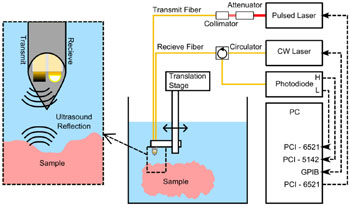Detailed Real-Time Imaging Using Optical Ultrasound Probes to Be Used to Guide Surgical Tools
By MedImaging International staff writers
Posted on 02 Mar 2016
Researchers have developed a novel technique that can help guide surgical procedures more precisely and efficiently.Posted on 02 Mar 2016
The minimally invasive real-time technique uses optical ultrasound probes, that send and receive ultrasound waves using light, to provide detailed images and guide surgical tools. The new optical ultrasound probes are designed to be integrated into needles, catheters, and other devices, and provide detailed images from inside the body.

Image: System setup showing ultrasound generation on the left, and detection fiber in the tubular metal housing (Photo Courtesy of OSA Publishing).
The probes are being developed by Dr. Adrien Desjardins of University College London (London, UK), a recipient of the EPSRC Healthcare Technologies Challenge Awards, together with a team of nine researchers. The awards are designed to encourage research for improved diagnosis and treatment, and to help speed up the clinical adoption of the new technologies.
The technique uses optical fibers coated in a thin micron-scale layer carbon-polymer nanocomposites, or another optically-absorbing material. Laser pulses are targeted at the coating, which heats up, and generate ultrasound waves. The ultrasound wave moves through the body and is reflected from inside human tissue. The waves are then received by very sensitive optical elements called Fabry-Pérot cavities, which reflect light between two mirrored surfaces.
Dr. Desjardins, said, “Ultrasound imaging can provide exquisite visualization of tissue from within the body to guide minimally invasive medical procedures. Currently, though, ultrasound imaging is performed with electronic transducers, which have costs that are often prohibitive for single-use medical devices, and they are too bulky for many procedures. By varying the location in the tissue in which the ultrasound wave is generated, signals can be acquired and processed to produce high-resolution pulse-echo ultrasound images in real time from within the body.”
Related Links:
University College London










 Guided Devices.jpg)



